A contemplative art work on the Resurrection of Jesus, using light and darkness, through the large format film photographic process.
Inspirations for this contemporary piece
It was an art process that started with a sketch on a phone. Since my conceptual fine art work started with a pro life image, I had been yearning to create something again, something that reflected a wish to give back to God, as well as create something beautiful. As I lay in bed, an image came to me of a flower in water, surrounded by a cross of light. I was thinking of light coming in through a roof within darkness. My aim was to symbolically represent the Resurrection. I looked up flower symbolism in the Catholic Church, and settled on the lily, due to its assocations with resurrection due to its dormant state prior to blooming. Immediately, as I sketched, I was thinking about how I could possibly achieve this within photography, particularly the cross of light in darkness.
Beginnings in Light and Dark
With my idea for construction of the light formed, I bought the lillies and began. At first, the lillies were closed, and so my first image was shot on the phone. I had been unable to contain my excitement, and needed to see and experiment.
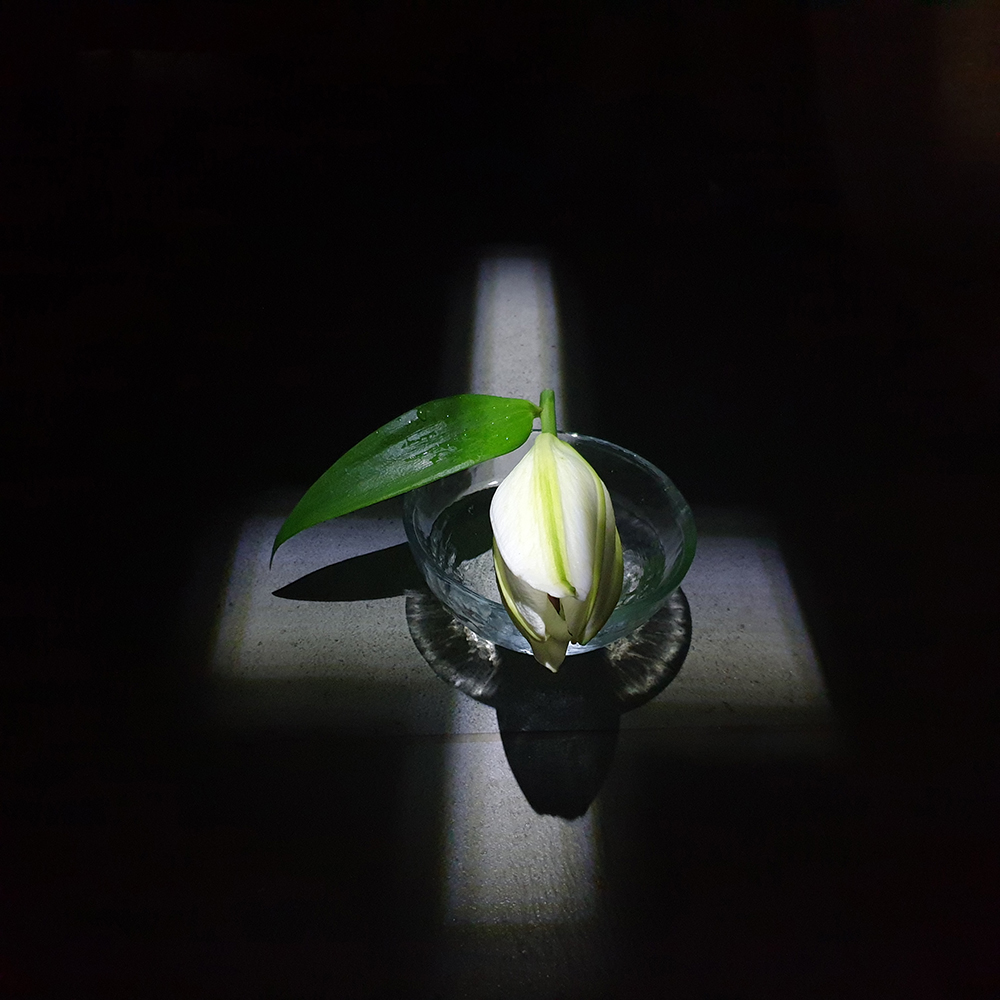
By the following day, a flower had bloomed, giving me an opportunity to really approach the work, and so I took the first real photo, placing the lily in a small glass dish of water. The stone and light, with the lily on the floor, created a partial idea. I felt like this was a tomb scene. From there, I added a title. I thought pthat perhaps my local church could use it, and so the title was an example of utility.
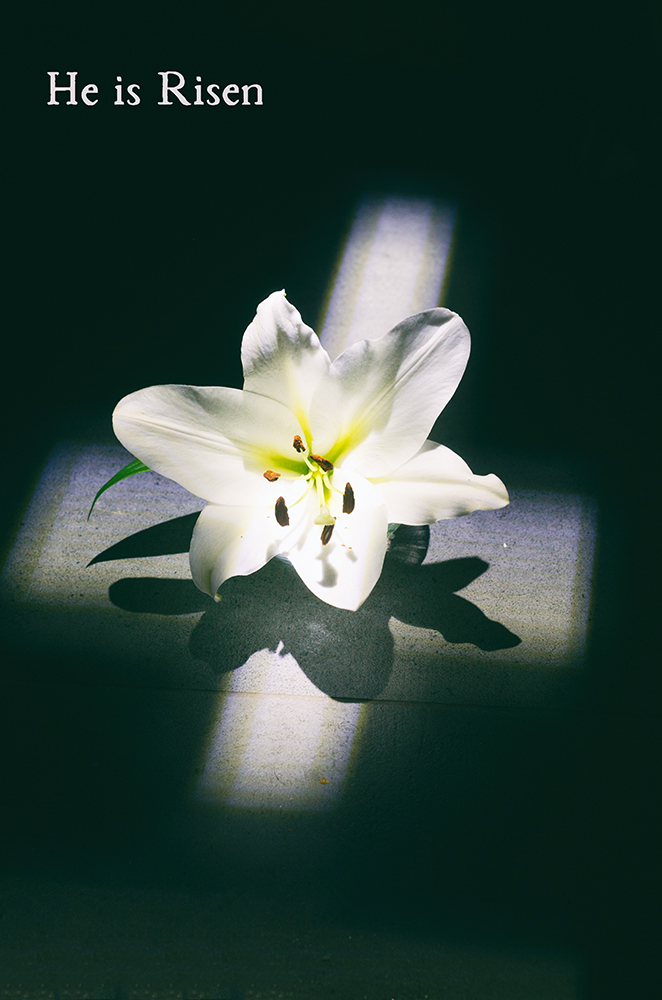
At this point, although I liked the image, two things were upsetting me. Firstly, that the cross could be interpretted as being upside down, instead of flat, and with the image taken from the head. Secondly, I couldn’t get large format film out of my head. How would this look, in all of large format’s beautiful tonality?
So, the next day came, and I took a further two images. I won’t bore you with the first – there will already be a lot of images in the post. Suffice to say, I was unhappy with the composition. The second image I took was that below.
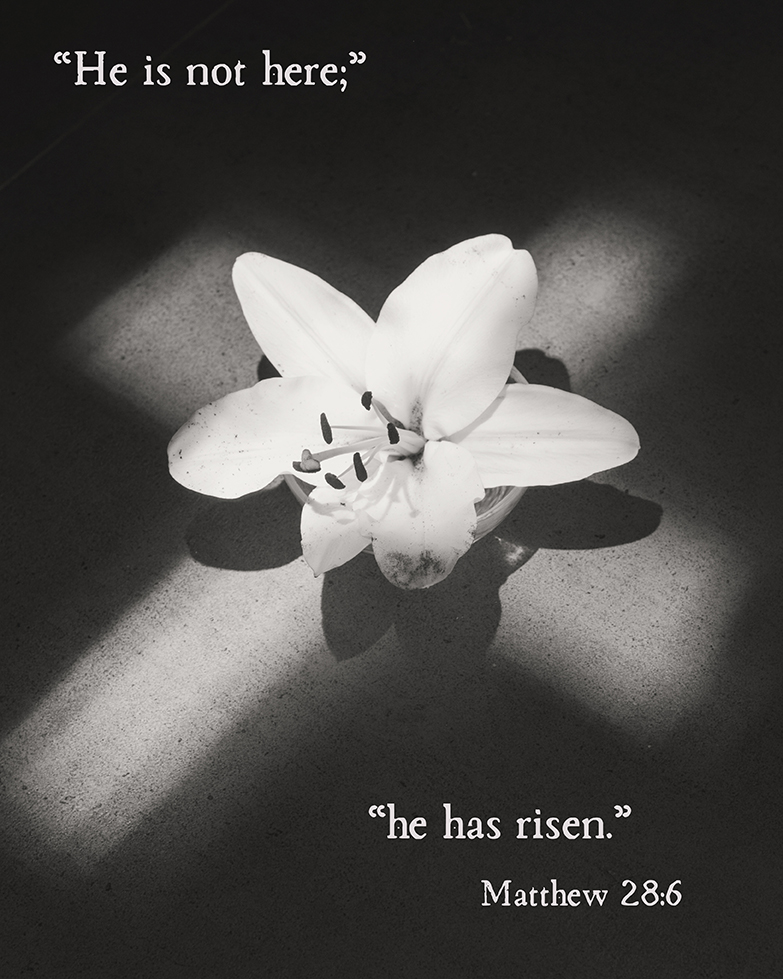
With this image, the photographing angle of the cross was moved to a diagonal postion. This filled the frame nicely. However, the colours of the flower were not perfect white, instead resembling something injured, or dying. This did not suit the idea for a resurrection piece, and so I converted to black and white.
Time passed, and something began to bother me again. The flower looked slightly wilted, and the pollen damage to the petals was still visible. The flower did not have the crispness of the previous image, and was not really joyess, in line with the Resurrection. As my father pointed out, this was more like death on the cross.
At that point, I thought hope was lost, as I presumed the wilted flower was representative of a wider loss of quality in the flowers.
Another day, another look at the lillies. This time I noticed one flower was still partially closed. I realised that this meant I had maybe one more opportunity. And so I prized the flower open slightly, placed into the water dish again.
What I have failed to indicate so far, is that this had been a laboursome process. For each shot, I needed the use of a tripod, plus long waits for adequate exposure. My camera was also broken in a large sense, the shutter refusing to fire in aperture priority, and manual refusing to allow me to change shutter speed with the dial. And so, I took to guessing with the EV exposure dial. Also, there was the issue of focussing in the dark through the viewfinder, since my live screen was also not working. All of this was much harder than it sounds, and took a great many shots.
Finally, though, I did have one shot that was acceptable.
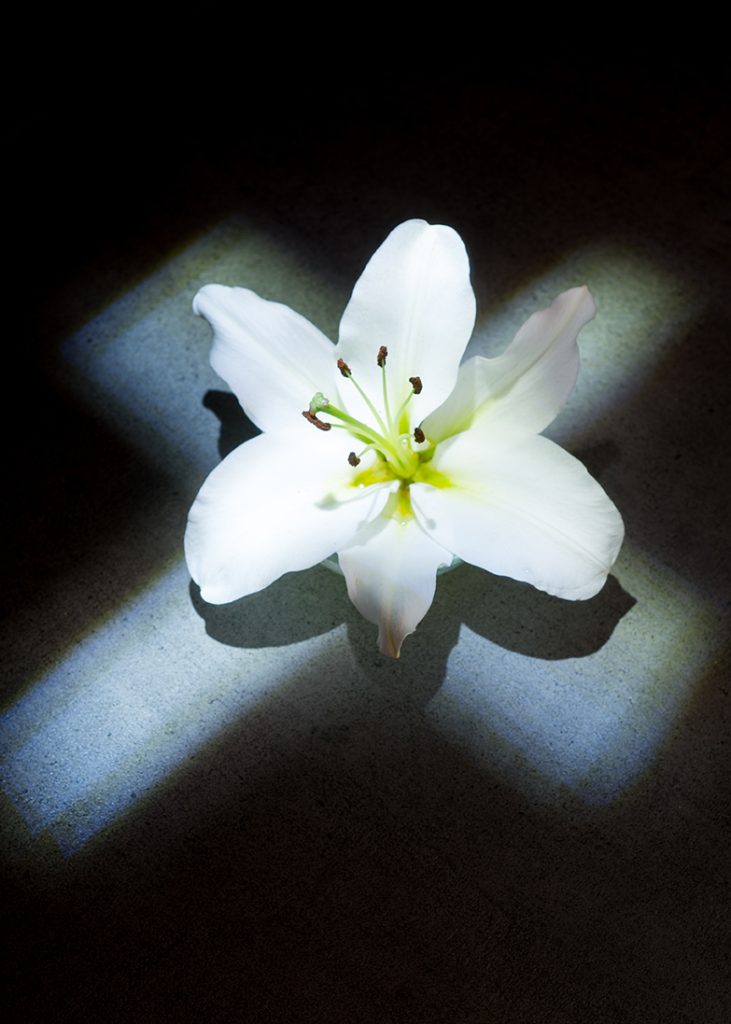
Initially I was pleased. I uploaded to Instagram. I even ordered a large print.
The print arrived, I was relatively pleased. But something was niggling at me… Firstly, the idea of the tomb had formed more vividly in my mind. I wanted it to also form in the mind of the viewer. I thought with the title this should be enough; people would think of the tomb. However, there was also something else pressing me. A niggling doubt that the work was not the final image. Although it was symbolic, with the lily, the stone floor, the title, I wanted to explore the Resurection symbolism more concretely.
A Segue into Shadow
Through dwelling on this predicament, a new idea formed. I wanted to place Mary Magdalene and an Angel into this tomb of light surrounded by darkness. I also wanted the cross to be upright.
I got to experimenting again. At first, I wanted to make their representation subtle, and so I initially cast them as shadows. But this created a two-fold problem. Firstly, I felt that this was amateurish. Secondly, they were difficult to identify. And thirdly, due to my execution of the images in side profile (for easier identification), the question then became how to postion the flower.
Further experiments and deliberation led me to the conclusion that no, this was not working. It wasn’t working on a fine art level, and it wasn’t working at the conceptual level. I wanted these images to feel more real.
Sacred Models and Flowers of Beauty
This led to the model search. This was a long stage. I became obsessed with finding figures for Mary Magdalene and the angel. Due to my light source, they also needed to be perfect matching sizes. I won’t say how I arrived at the models, or how I altered. I’ll leave that up to the imagination.
At the same time, I had been thinking about the lily. Again, I wasn’t happy with the obvious symbolism, and how prevalently it was used. But I did want a flower that was white. Ideally, one that bloomed at Easter. I eventually settled on the Ranunculus, round about the time that my model search finished. I loved the concentric lines, but was less happy at its general association with marriage, rather than Easter. It’s beauty, I felt, though, was unsurpassed in the context of the image I was envisioning. I had decided that I wished flowers not just to vacate the space that Jesus left, but also to decorate the cross. I wanted this to be a beautiful image, something fitting for the message of Easter in all stages: Crucification, Entombment, and Resurrection. Indeed, I wanted the image to represent all stages of Easter, and include the beauty and joyous message that has been delivered to us.
There was a problem though. Ranunculus were only supposed to bloom until somewhere between the start and mid of May. Looking online at the ever increasing “Out of Stock” messages, probably due to the encroachment of Mother’s Day, I realised that my dream picture was disappearing. At least, the image I had constructed in my head was maybe going to have to change. I was still waiting for the models to arrive.
Indeed, when I received the date for model delivery, I went out a day earlier to source Ranunculus, but I was pessimistic. I can be quite OCD, so I was wondering how I could possibly recover the image without Ranunculus. In the end. the shops didn’t have any. But there was also a surprise. As I went around the shop, and turned the final corner, a white flower caught my eye. As I leaned in closer, I realised that it was utterly beautiful. I briefly looked up the bloom time: Available All Year round. But I didn’t care. I was mesmerized. That flower was the Eustoma. I knew that this would provide the beauty to the photo that perhaps was missing with the large, unruly, and hard to manage lily. I would place the flowers on the arms of the cross, and also the head. The aim was beauty. When we think about what Jesus did for us through the cross, the pain that must have been experienced, for people he did not know, many yet to be born, it is an incredibly beautiful thing.
At this stage, I still wanted to be explicit about the resurrection – I was unsure if the Estoma could achieve this, so I still considered the lily as a centre piece. Fortunately, I was unable to find a boquet before the next bus arrived, and my priority was getting the Eustoma back to safety.
Once home, I realised that the Eustoma would fit perfectly into the image, that it was about arrangement.
I did decide, though, that such an elaborate and expensive photography project was worthy of a large format shot. Everything needed to be perfect though, to come together in unison.
The Move to Large Format Resurrection Art
Eventually the models arrived, and I was extemely pleased, after some further expensive alterations. A lot was riding on the next shoot.
And so, a window appeared where I felt I might have time to take the shot. I had sourced chemicals and other bits and bobs needed to make the shoot, and develop the negatives.
Once again, darkness descended, and the adrenaline kicked in. I need to get everything right for the large format shoot. I only had two sheets loaded into holders, and there were lots of calculations to be made. Focussing was a nightmare, and there still needed to be some guesswork here. The glass screen was practically black.
Eventually, the two shots were taken at long exposures. One bracketed below the other in case calulations were wrong.
Home Darkroom Development
Then there was an excruciating wait. Family comittments meant that that was no more time until the evening, when everyone had gone to bed. It was with a combination of excitement and peturbation that I got the bathroom ready. When it comes to large format development, I can’t leave it to development houses, firstly because I would never be able to forgive them if there was a mistake, and secondly because developing youself means you can adapt to the circumstances that arise.
So, I set up my water bath and chemicals, ensuring that the fan was on for ventillation.
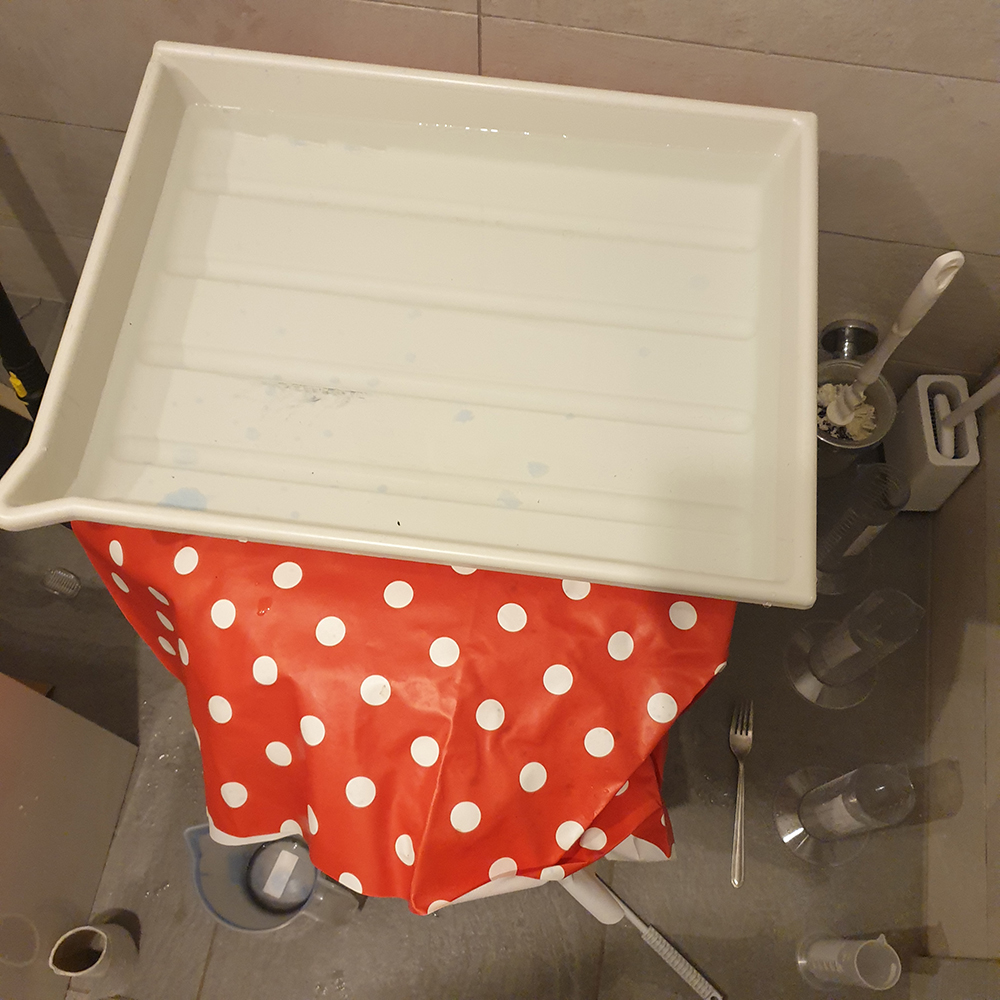
I also set up my hand-adapted Paterson Orbital, which allows me to develop in the light. Eagle eyed viewers will notice that this shot was taken after development…
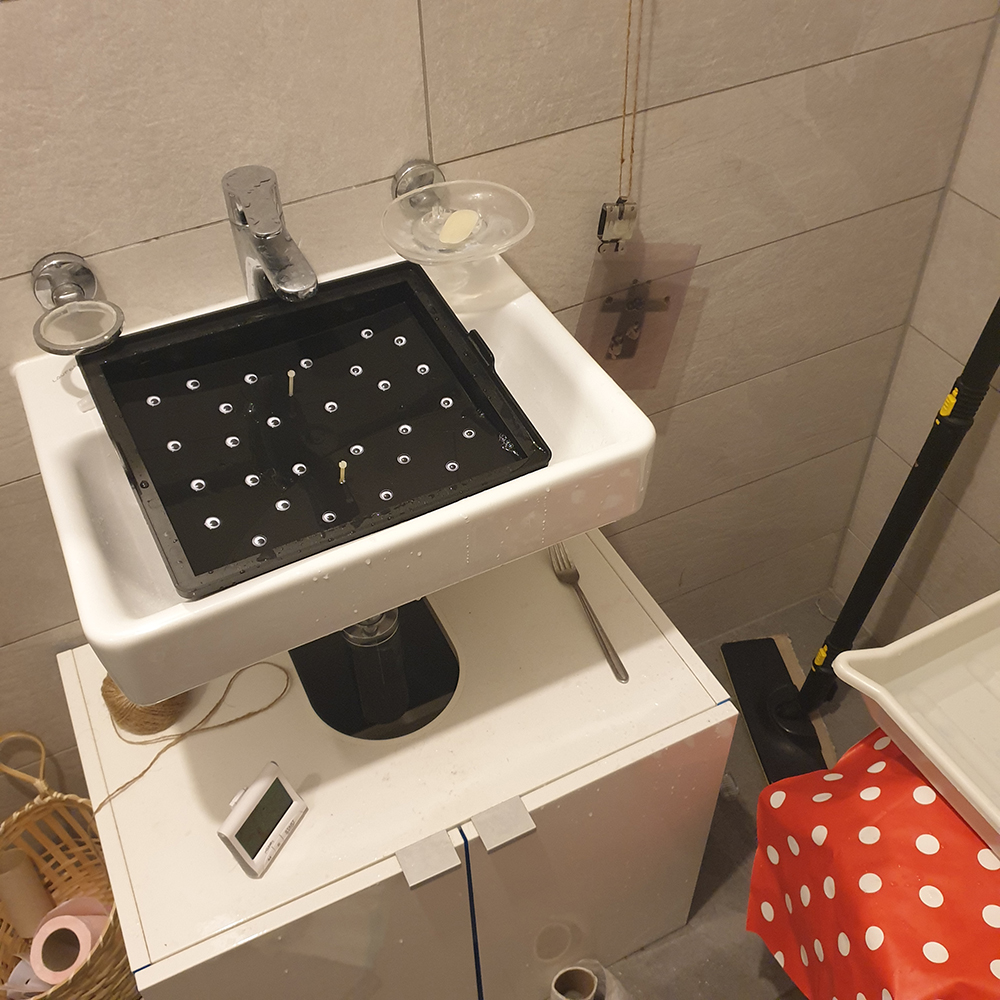
After many checks, and double checks, and waits for temperatures to equalize, development started. At each stage (presoak, development, stop, fix), you visualise the negative, imaginging what is happening to those crystals. Did I expose too long, too little? Was focus right; did I remember to stop down? Am I developing right, did I make the correct mix of chemicals? What if just one of my calculations was wrong. It is a stressful yet somehow enjoyable experience. Not to mention that the whole process, even if you understand it, still feels magical. Light is magical.
The final stage is the wash at the end. And it is here that you remove the lid. I breathed a sigh of relief when I saw the black cross (everything is reversed with a negative). I knew that I at least had something workable.
Closer inspection seemed to show that there was adequate exposure.
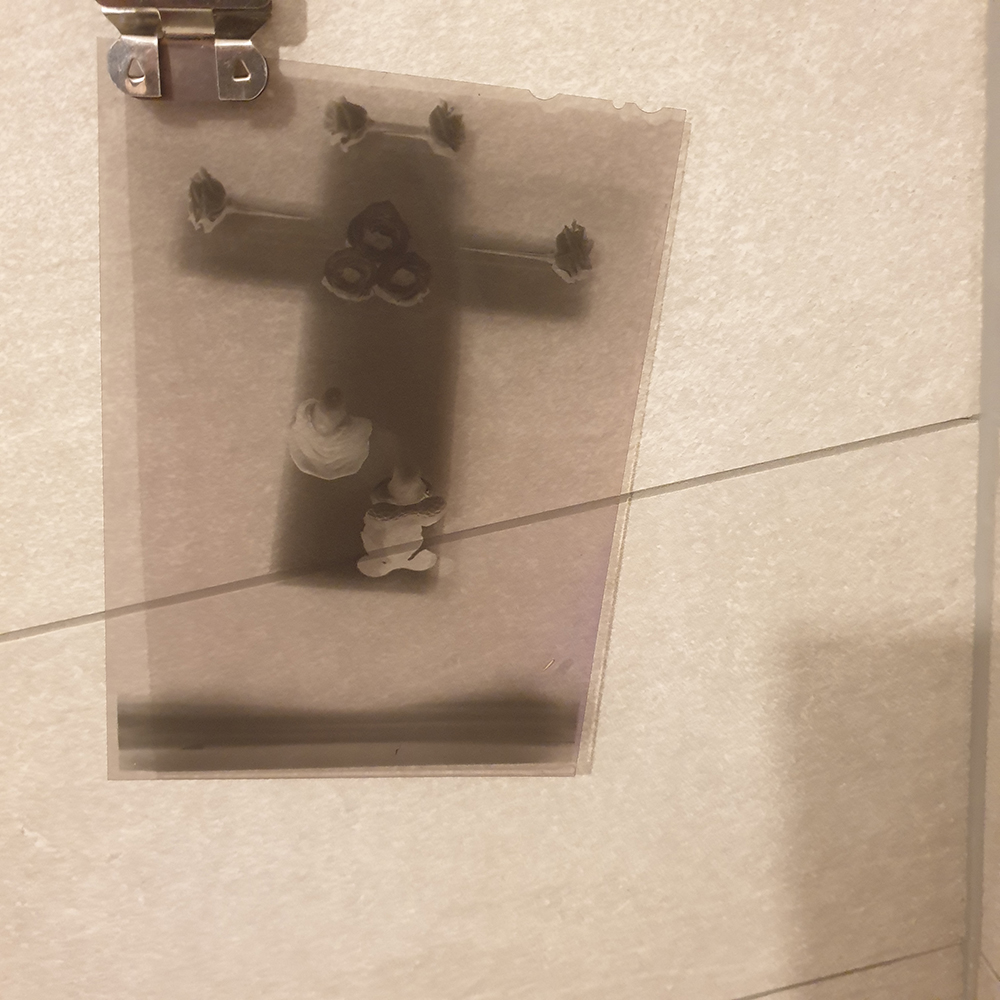
But there was shock and horror when it dawned on me that the central flowers were not quite central. I would need another negative. And would the flowers be central on these? Also, what exposure was I looking at (I had forgotten to label the holders with exposure post-its). I guessed that it was the normal exposure, which meant that the next exposure would need to be pushed by a stop. Again, a further calculation was needed. I prepared the chemicals once more…
Whilst waiting, I used the negative picture I had taken (since the negative was still too wet to handle) and inverted the image in photoshop express.

My excitement built. I felt that if the second image developed correctly, then I would have a successful image with cropping a little. Composing in the dark had casued some issues…
Finally chemicals were ready, and I developed the next image. Thankfully, the push seemed to have worked, and I had an almost identical image, but with the flowers central. I was elated. Perhaps too much so. As I left the negatives to dry, I knew I would find it hard to sleep.
Immediately after family commitments were completed the next day, I jumped onto my scanner to scan the second negative, The first thing I was unprepared for was the red tinge to the scanned negative. I later realised I had not read up enough on reciprocity. I managed to correct this back to black and white in Lightroom, and this is the image I was left with:
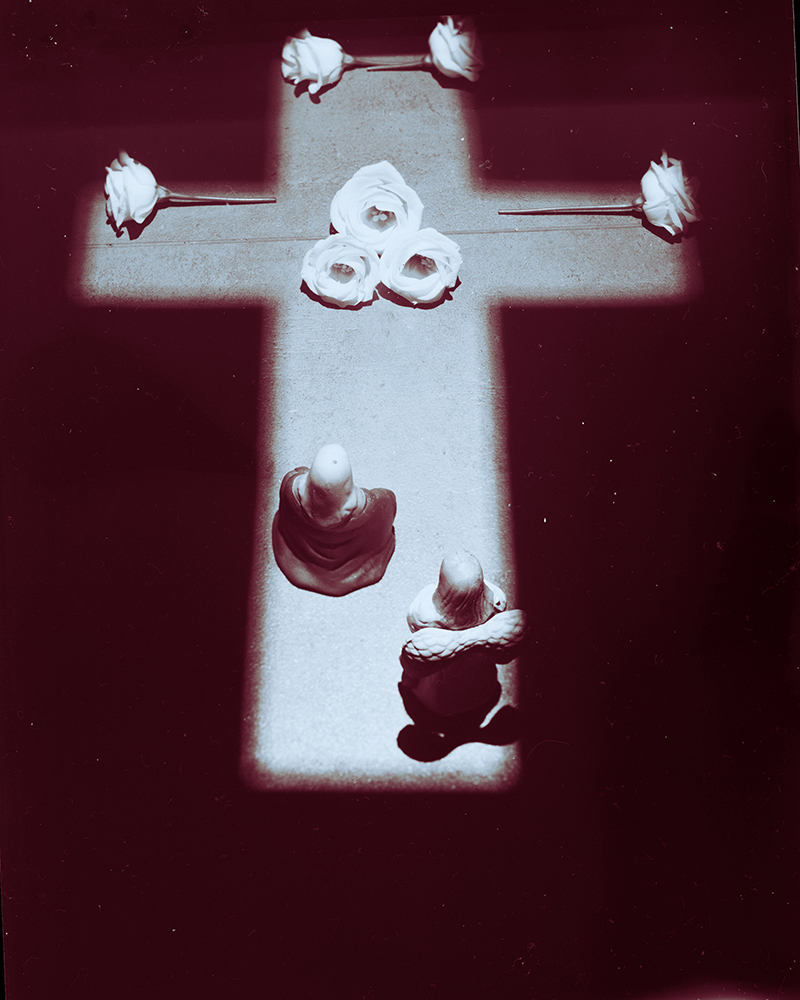
Intentionally, I left the red glowing border around the cross. Although this image pleased me, it still wasn’t right. It felt like someone was visiting someone still entoumbed, or it could be interpreted that reverence was being given to death, and not the risen Jesus at all. I realised there would need to be another shoot. But would the flowers last?
They did indeed last, although perhaps I had taken the best ones. There is always difficulty with large format shoots, especially ones with long exposures and limited film and chemicals. Will you get it right? Or will everything have been a failure?
The Final Shoot
Next day, next shoot. This time, I adjusted the positioning of the figures. Again, I won’t give all my reasons, leaving it to mystery. I also took extra care on compositon. I thought I had placed the cross centrally the last time, but there had been a mistake. This time, I was a little further out, which confused me. The tape still seemed to read the same difference, which with hindsight perhaps pointed to a change of cross position. We will never know. Exposure was also up, although a terrible reciprocity calculation failure was avoided at the last minute. It was enough to set me on edge, and readjust the scene one more time. This time, I took extra care on the flowers, making sure centrality was obeyed, and observence to the position of the light.
The wait as exposures were taken was particularly hard to experience this time. I wanted to see the final images.
And so, once again, I went back to my chemical “darkroom”, set up shop, and began to develop. It was harder this time. It is quite a labourisome process, standing and crouching, agitated the tank, and trying not to do so too little or too vigourously, and also trying not to make a mistake with pouring the chemicals, etc.
FInally, it was time for the wash. And here is where I am unsure what happened. I opened the box, was greeted the black cross, and then suddenly white globules seemed to burn onto the negative, right before my eyes. I am unsure if they were already there, or whether it was exposure to the light or water, but there it was. A ruined negative. But wait… I looked closer, and the artifact, although large, seemed to have left the whole cross and flowers intact. I wondered if I could do something with it.
Untimately, though, as I hung it up on the wall, I was frustrated. With these long exposures, I was concerned that by the time of the second exposure, the flowers may have wilted a little. Perhaps this process would make the flowers blur under such long exposures. I wan’t sure. I knew from my previous pro-life shoot that roses wilt rather quickly outside of water. Perhaps the Eustoma would be different? I really wasn’t sure. Also, as I had returned to the scene after the second shot, I noticed everything out of line on the cross. How had this occured? I eventually came to realise that it was probably a change with the light source. But if the image reflected that final state, or indeed emcompassed the previous state, plus the new state, then the image would be ruined. I commenced with development, but was once again assailed with pessimism. I looked long and hard at the ruined negative hanging on the wall, staring intently at the artifacts.
It was then that I had a strange realisation. WIth all of the Resurrection symbolism floating around in my head, and also chemical processing, I started to see something different in that ruined negative. It began to remind me of the Turin Shroud, with its artifacts (a result of burning, as I later found out). Not because it had the face of Jesus, but because this was an artifact of light (or at least, an atifact of the process of capturing light).
I would still have to wait though. I was developing the second negative. This, suprisingly, came out perfectly. The flowers were all aligned, and the cross had definite shape, indicating that the change to scene must have ocurred at, or near the end of the exposure. Perhaps my coming through from the other room as my timer went off caused something to be knocked out of place. No matter. I was excited. Increasingly, though, as I cleaned the kitchen, I realised I was becoming excited for the first negative of the day. What would that artifact look like?
FInally, I was able to scan. As the image appeared, it was even more red than yesterday’s negatives. I adjusted till it was pleasing to the eye, and I realised that I liked the artifact very much. Indeed, the flowers and cross were preserved almost perfectly, as I had expected, with only minor distortion. I was elated. The red outline to the cross glowed. This was it, the final image. (Print version shown below)
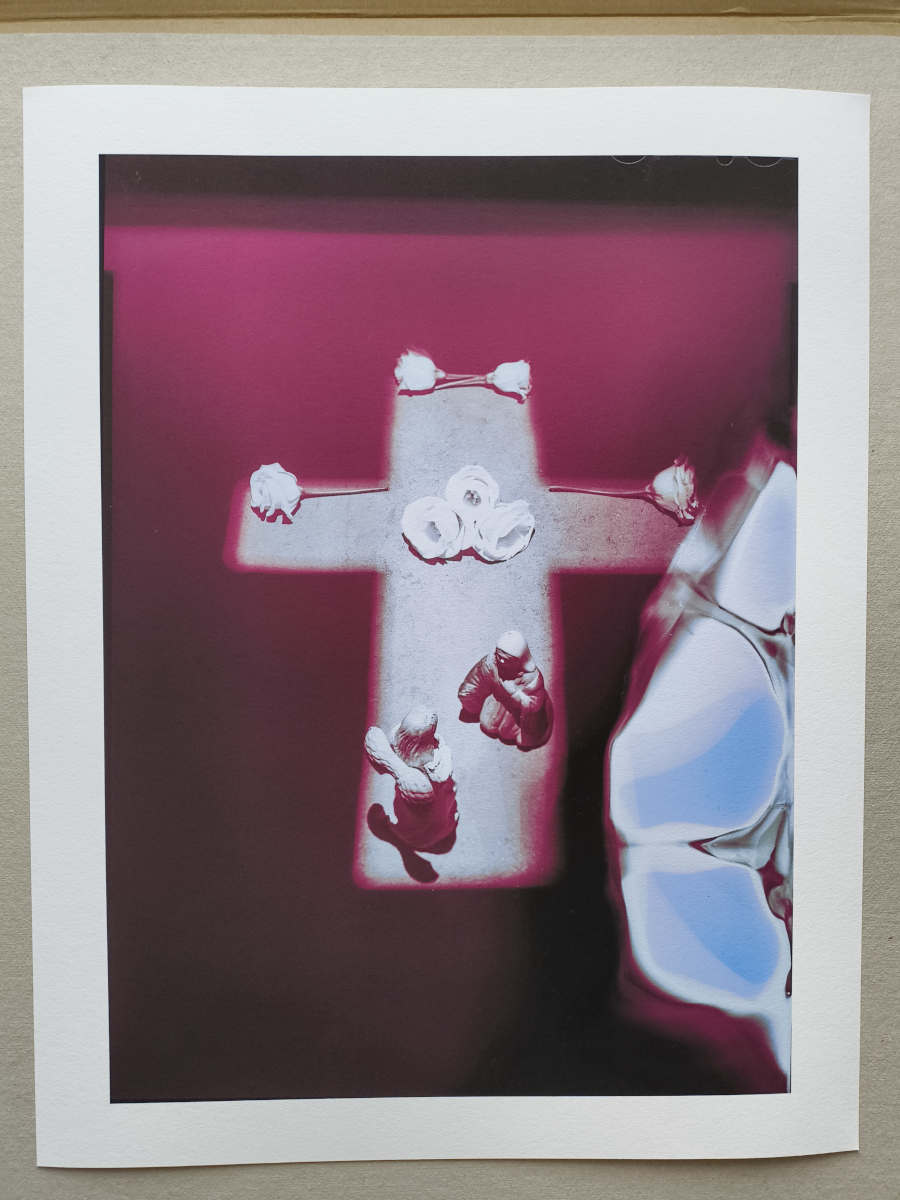
I scanned the other image, and it did indeed come out perfectly, but it was missing the beautiful artifact. It was red of course, like the other, but it felt more empty.
The final image, by contrast, felt alive and dynamic.
Leave a Reply